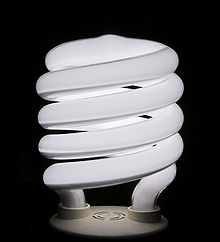
How to Safely Cleanup Broken Compact Fluorescent Bulbs
As discussed in an older blog of mine (Green Fascism), Compact Fluorescent Bulbs (CFBs) are extremely dangerous, and a far cry from being “green.” Following is an excerpt from my soon-to-be-published “Health Secrets Volume 2: Surviving the Modern Age”, in which I discuss the safe way to clean up after breaking one of these mercury-containing “green” bulbs.
GREEN BULBS
These so called “green” bulbs save energy; that is their claim to fame and their one advantage. However, for those of us in the temperate to cold zones, the energy saved from the light bulb will have to be replaced with an identical thermal unit of energy, acquired from conventional heating sources. So, the green light bulb is really only of value, from an energy perspective, in warm and hot areas, and in the summer for the rest of us. However, even this slight energy advantage is outweighed by the dangers that these bulbs pose.
There are three serious problems with CFB:
- They put out high levels of ultraviolet radiation, enough to damage the skin if you sit too close to them, unless they are “shielded” – which appears as a cover over the familiar spiral shape.
- These bulbs also emit huge amounts of EMFs, which tend to have the strongest negative effect on people already ill: those with compromised immune systems, neurological disorders, or electro-magnetic sensitivities.
- Finally, to add insult to injury, if these green bulbs break, they release toxic amounts of mercury, and one needs to follow hazardous material clean-up protocols.
Mercury is not very green is it? Yet someone decided for you that saving energy outweighs dumping more mercury into the environment, because ultimately a lot of them are going to break and not be properly cleaned up, and many are headed for the landfill. They decided this, and then they mandated it, so that incandescent bulbs have been outlawed at the higher-wattage levels, and, supposedly, eventually all incandescent bulbs are to be outlawed – varying somewhat based on where you live.
COMPACT FLUORESCENT BULB CLEAN-UP
Most major retailers that sell CFBs offer free recycling collection for unbroken bulbs. As well, there is a recycle organization in most of the Canadian provinces (and a few US states), that takes these bulbs for recycling, even if they are broken (provided that they are in a sealed plastic bag, or sealed glass container. (www.lightrecycle.ca)
The Maine State Government (providing the most thorough clean-up protocol that I could find) recommends the following clean-up and disposal guidelines:
- Wear disposable gloves, and before clean-up, vent the room, opening at least one window, and stay out of the room for at least 15 minutes after the breakage occurs. Ideally wear a surgical-style disposable face mask while doing the clean-up process; or, at least, breathe as little as possible during this time.
- If you have central forced air heating or an air conditioning system, shut them off during the process.
- When cleaning up a broken bulb on a hard surface, carefully scoop up the glass fragments and powder using stiff paper or cardboard, and place them in a glass jar with a metal lid (such as a canning jar) or in a sealed thick plastic bag. Then use sticky tape, such as duct or packing tape, to pick up any remaining small glass fragments and powder, and put that into the container as well.
- Wipe the area clean with damp paper towels, or disposable wet wipes, and also place them in the glass jar, or plastic bag.
- Do not use a vacuum or broom to clean up the broken bulb on the hard surfaces, as that can cause the mercury powder to become airborne.
- When cleaning up a broken bulb on carpet or rug carefully pick up glass fragments and place them in a glass jar with metal lid, or in a sealed thick plastic bag. Use sticky tape to pick up any remaining small glass fragments and powder.
- When cleaning up carpet or rugs vacuuming may be needed after all visible materials are removed, since the remains cannot be wiped up with damp paper towels. Vacuum the area where the bulb was broken, definitely wearing a mask, and ensuring that there is air flow through the room. Then remove the vacuum bag (or empty and thoroughly wipe the canister), and put the bag or vacuum debris in the glass jar, or sealed plastic bag.
- Immediately place the sealed cleanup materials and broken bulb outside the building until you are ready to dispose of it at a recycling center.
- Wash your hands and any exposed areas after removing gloves and disposing of the jars or plastic bags containing clean-up materials.
- Any future cleaning of carpet or rug should be done while venting the room, both during and after vacuuming. For at least the next few times you vacuum, shut off the central forced-air heating or air conditioning system, and open a window prior to vacuuming. Keep the central heating/air conditioning system shut off and the window open for at least 15 minutes after vacuuming is completed.
Personally, I would suggest using incandescent or LED lights exclusively, whenever and where ever possible.